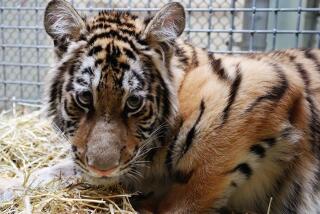Rare Tiger’s Death on Flight to Zoo Probed : Animals: The cub from Malaysia was bound for breeding program in San Diego. It was confined in cargo hold in a small crate with poor ventilation.
- Share via
SAN DIEGO — A rare Malaysian tiger, one of only about 200 in existence, died while being flown from Kuala Lumpur to Los Angeles after being placed by Malaysian authorities in a crate that was partly wrapped in plastic and barely larger than the animal itself, authorities said Tuesday.
The 100-pound female tiger was one of two 10-month-old sister cubs that were destined on Feb. 19 for the San Diego Zoo, which plans to establish a breeding program for the endangered animal, distinctive for its bright orange coloring and black stripes.
The animal was ailing--if not already dead--when a Malaysian Airlines 747 stopped for two hours in Honolulu and ground cargo handlers said they smelled something foul. But before a veterinarian for the U.S. Department of Agriculture could arrive at the airport to check on the animal’s condition, the airliner already had taken off for Los Angeles.
When the plane landed at Los Angeles on Feb. 19, concluding the 24-hour trip, the cub was dead, either from dehydration or because it apparently had become overheated in its small wooden cage, said Dr. Ron DeHaven, animal care supervisor for the USDA in Sacramento.
“The cage was barely larger than the animal itself,” DeHaven said. “It literally could not stand up in the crate. There was no ventilation. It was a solid wooden crate except for one end, the tail end, where there was heavy gauge wire.
“But the crate was wrapped in plastic halfway up, so that half was cut off to ventilation,” he said.
The animal was 43 inches long from the crown of its head to the base of its tail, and the cage was just 46 inches long, a USDA inspection showed. The cage was 23 1/2 inches high and 22 1/2 inches wide.
The investigation into the cub’s death will focus on cargo handlers in Honolulu and whether the animal was properly caged for shipment in Kuala Lumpur, where the two cubs were born in captivity, according to sources close to the investigation.
The two tigers were on loan from the Malaysian Wildlife Authority to the San Diego Zoo. Officials for the wildlife authority could not be reached for comment Tuesday.
“It’s beyond disappointment,” said Jeff Jouett, spokesman for the San Diego Zoological Society, which operates the San Diego Zoo, where the two cubs were headed. “We’re outraged about this. We’re mad as hell.
“There can be no excuse for how those tigers were shipped, and we’re hoping someone will be called to account for it,” Jouett said. “To say that we’re shocked, saddened and angered is putting it mildly.”
The surviving female cub--which was said to be “stressed” by the flight--is now in routine quarantine at the San Diego Zoo.
At the zoo’s request, the U.S. Fish and Wildlife Service began an investigation into the incident and is considering pressing criminal or civil charges, said Larry Farrington, senior special agent for its Los Angeles office.
Farrington said that the reason one animal died and the other lived may be because “the cage with the live animal was bigger than (that of) the dead animal. This is pretty simple stuff.”
The cub’s death is the second in recent weeks involving the transportation of exotic animals. Last Friday, Hannibal, the Los Angeles Zoo’s five-ton African bull elephant, died after being sedated for shipment to Mexico.
The International Air Transport Assn. sets guidelines for its members--including Malaysian Airlines--on the shipment of live animals, including specifications for adequate ventilation with air holes.
A USDA inspector said that of the cage’s six walls, only one--at the cub’s rear--had ventilation, through heavy gauge mesh wire. There were no other breathing holes and the bottom and inside walls were lined with metal sheet, he noted in an internal memo to his boss.
A USDA veterinarian in Honolulu, Dr. Elizabeth Lyons, said she learned from authorities in Honolulu that the airplane containing the two tigers had landed there, and that one was in distress, according to a USDA memo obtained by The Times.
But by the time she got to the airport, the jumbo jet had left. She called to alert the San Diego Zoo.
“No care was provided for either tiger in Hawaii,” USDA veterinarian Wensley Koch wrote in his report to DeHaven and other superiors.
Ralph Knox, administrative executive for Malaysian Airlines’ North America operations, said he had “heard about the incident” but knew few details.
“The shipper does the crating and all the handling,” Knox said. “And the animal is only accepted according to the guidelines of live animal carriage. Our agent looks at the documents and the cage, but he does not, nor is expected to, have expertise on the health and condition of the animal.”
More to Read
Sign up for Essential California
The most important California stories and recommendations in your inbox every morning.
You may occasionally receive promotional content from the Los Angeles Times.













